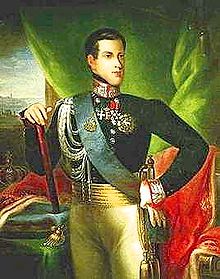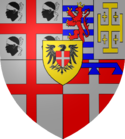- Charles Albert of Sardinia
-
Charles Albert 
King of Sardinia Reign 27 April 1831 – 23 March 1849 Predecessor Charles Felix Successor Victor Emmanuel II Spouse Maria Theresa of Austria Issue Victor Emmanuel II of Italy
Ferdinand, Duke of GenoaFull name Carlo Alberto Amedeo di Savoia House House of Savoy Father Charles Emmanuel, Prince of Carignano Mother Maria Christina of Saxony Born 2 October 1798
Palazzo Carignano, Kingdom of Piedmont-SardiniaDied 28 July 1849 (aged 50)
Porto, Kingdom of PortugalBurial Basilica of Superga, Turin Charles Albert (Carlo Alberto Amedeo; 2 October 1798 – 28 July 1849) was the King of Piedmont-Sardinia from 1831 to 1849. He succeeded his distant cousin Charles Felix, and his name is bound with the first Italian statute and the First War of Independence (1848–49). He abdicated after his forces were defeated by the Austrian army at the Battle of Novara (1849), and died in exile soon thereafter.
Contents
Biography
He was born in Turin in 1798, to Charles Emmanuel, Prince of Carignano and Maria Cristina of Saxony. His father was a fifth-generation descendant of Thomas Francis, Prince of Carignano, founder of the Savoy-Carignano line of the House of Savoy. Because none of the sons of Victor Amadeus III themselves had sons, Charles Albert was throughout his life known to be their likely successor on the throne of Sardinia.
He was educated in the intellectually liberal and Francophile atmosphere of Geneva, then in Paris during the First French Empire. Napoleon I of France named him lieutenant of the dragoons in 1814. After the fall of Napoleon, Charles Albert returned to Turin. Two mentors were entrusted with countering the dangerous ideas about national liberation Charles had learned in France. However, he continued to display some sympathies with liberals.
In 1821, as regent for the kingdom in the absence of the new king, Charles Felix (then in Modena), he conceded a constitution that was disavowed by the king, who sent him to join the French army in Spain to suppress the liberal revolution there and restore Ferdinand VII. He distinguished himself at the Battle of Trocadero in 1823, which annihilated hopes of a constitutional monarchy for Spain and also gained him the favour of Austria.
Charles Albert succeeded Charles Felix to the throne of Sardinia in 1831. Although an Italian patriot allegedly opposed to the Austrian hegemony in Northern Italy, he put down the Mazzini conspiracy. He introduced a series of reforms that abolished domestic customs barriers within the kingdom, promulgated a constitutional law code (Statuto Albertino) inspired to those of France and Belgium, and supported the arts and sciences.
During the Revolutions of 1848 he agreed to a constitutional regime that remained in place for the century that the Kingdom of Italy lasted. The same year he declared war on Austria, with the small army supported by volunteers from the whole of Italy. However, after his initial victories lost him the support of the Pope and the other Italian monarchs, he was defeated at Battle of Custoza (24 July 1848), being forced to sign an armistice at Vigevano on 9 August. When, pushed by the increasing influence of the Republicans in Piedmont, he attempted to resume the war the next year, the Piedmontese were again crushed by Radetzky's troops at Novara. Rather than redrawing the Statute, he abdicated in favour of his son, Victor Emmanuel fleeing in exile to Portugal.
He died at Porto the same year. His remains were transferred to the Basilica of Superga.
Friedrich Engels said of Charles Albert:
Among the indigenous princes, the number one enemy of Italian freedom was and is Charles Albert. The Italians should bear in mind and repeat every hour the old saying: "God watch over my friends, so that I can watch over my enemies." From Ferdinand of the House of Bourbon, there is nothing to fear; he has for a long time been discredited. Charles Albert on the other hand calls himself pompously the "liberator of Italy" while on the very people he is supposed to be liberating he imposes as a condition the yoke of his rule (Neue Rheinische Zeitung No. 73, 12 August 1848).
Family and children
In 1817, Charles Albert married his second cousin once removed, Maria Theresa of Austria, the youngest daughter of Ferdinand III, Grand Duke of Tuscany, and Princess Luisa of Naples and Sicily. The couple had the following children:
- Victor Emmanuel II (1820–78) married Adelaide of Austria
- Prince Ferdinand of Savoy (1822–55), Duke of Genoa married Princess Elisabeth of Saxony
- Princess Maria Cristina of Savoy (1826–27) died in infancy.
Ancestry
Ancestors of Charles Albert of Sardinia 16. Victor Amadeus I, Prince of Carignano 8. Louis Victor, Prince of Carignano 17. Maria Vittoria Francesca of Savoy 4. Victor Amadeus II, Prince of Carignano 18. Ernest Leopold, Landgrave of Hesse-Rotenburg 9. Landgravine Christine Henriette of Hesse-Rotenburg 19. Countess Eleonore of Löwenstein-Wertheim-Rochefort 2. Charles Emmanuel, Prince of Carignano 20. Louis, Prince of Lambesc 10. Louis, Prince of Brionne 21. Jeanne Henriette Marguerite de Durfort 5. Princess Joséphine of Lorraine 22. Charles, Prince of Rochefort 11. Louise de Rohan 23. Eléonore Eugénie de Béthisy de Mézières 1. Charles Albert of Savoy 24. Augustus II the Strong 12. Augustus III of Poland 25. Christiane Eberhardine of Brandenburg-Bayreuth 6. Charles of Saxony, Duke of Courland 26. Joseph I, Holy Roman Emperor 13. Maria Josepha of Austria 27. Wilhelmina Amalia of Brunswick-Lüneburg 3. Princess Maria Christina of Saxony 14. Count Stanislaus von Corvin-Krasinski 7. Franciscka von Corvin-Krasinska See also
- Statuto Albertino
- First Italian War of Independence
- Risorgimento
External links
- Royal House of Savoy
- Grand-Ducal House of Tuscany
- Carlo Alberto
- Genealogy of recent members of the House of Savoy
- Genealogy.euweb.cz
Charles Albert of SardiniaBorn: 2 October 1798 Died: 28 July 1849Italian nobility Preceded by
Charles FelixKing of Sardinia
1831-1849Succeeded by
Victor Emmanuel II1st Generation none2nd Generation Prince Anthony · Prince Anthony · Louis, Duke of Savoy · Amadeus, Prince of Piemont · Philip, Prince of Achaea3rd Generation Amadeus, Duke of Savoy · Louis, Count of Geneva · Prince Giovanni · Philip, Duke of Savoy · Giano, Count of Faucigny and Geneva · Pietro, Bishop of Geneva · Prince Aimone · Prince Giacomo · Giovanni Ludovico, Bishop of Geneva · Jacques, Count of Romont4th Generation Prince Luigi · Carlo, Prince of Piedmont · Philibert, Duke of Savoy · Prince Bernardo · Charles, Duke of Savoy · James Louis, Count of Genevois · Prince Gian Claudio Galeazzo · Prince Girolamo · Philibert, Duke of Savoy · Charles, Duke of Savoy · Prince Louis · Philippe, Duke of Nemours · Prince Assolone · Prince Giovanni Amedeo · Prince Emanuele Filiberto Adriano · Prince Louis · Emmanuel Philibert, Duke of Savoy5th Generation Charles Emmanuel I, Duke of Savoy · Jacques, Duke of Nemours6th Generation Filippo Emanuele, Prince of Piedmont · Victor Amadeus I, Duke of Savoy · Charles Emmanuel, Duke of Nemours · Henri, Prince de Genevois · Prince Louis · Prince François Paul · Henri, Duke of Nemours · Thomas Francis, Prince of Carignano · Maurice, Cardinal of Savoy · Prince Emmanuel Filibert7th Generation Prince Louis Amadeus · Francis Hyacinth, Duke of Savoy · Charles Emmanuel II, Duke of Savoy · Emmanuel Philibert, Prince of Carignano · Joseph Emmanuel, Count of Soissons · Eugene Maurice, Count of Soissons8th Generation Victor Amadeus II, King of Sardinia · Victor Amadeus, Prince of Carignano · Louis Thomas, Count of Soissons · Emanuel Philibert, Count of Dreux · Prince Philippe · Prince Eugene · Prince Louis Jules9th Generation Victor Amadeus, Prince of Piedmont · Charles Emmanuel III, King of Sardinia · Emanuele Philibert, Duke of Chablais · Louis Victor, Prince of Carignano · Eugenio, Count of Villafranca · Prince Tommaso · Emmanuel Thomas, Count of Soissons10th Generation Victor Amadeus, Duke of Aosta · Victor Amadeus III, King of Sardinia · Emanuele Filiberto, Duke of Aosta · Carlo, Duke of Chablais · Carlo, Duke of Aosta · Benedetto, Duke of Chablais · Victor Amadeus II, Prince of Carignano · Prince Tommaso · Eugene Jean, Count of Soissons · Giuseppe Maria, Count of Villafranca11th Generation Charles Emmanuel IV, King of Sardinia · Amedeus Alexander, Duke of Montferrat · Victor Emmanuel I, King of Sardinia · Maurizio, Duke of Montferrat · Charles Felix, King of Sardinia · Giuseppe, Count of Asti · Charles Emmanuel, Prince of Carignano · Eugenio, Duke of Carignano12th Generation Charles Albert, King of Sardinia13th Generation Victor Emmanuel II, King of Italy · Ferdinand, Duke of Genoa14th Generation 15th Generation Victor Emmanuel III of Italy · Emanuele Filiberto, Duke of Aosta*** · Vittorio Emanuele, Count of Turin*** · Luigi Amedeo, Duke of the Abruzzi*** · Umberto, Count of Salemi*** · Ferdinando, Duke of Genoa** · Filiberto, Duke of Genoa** · Adalberto, Duke of Bergamo** · Eugenio, Duke of Genoa**16th Generation 17th Generation 18th Generation 19th generation Prince Umberto*** · Prince Amedeo****member of a cadet branch of the House of Savoy
**Prince of Savoy-Genoa
***Prince of Savoy-AostaThomas Francis (1620-1656) · Emmanuel Philibert (1656-1709) · Victor Amadeus (1709-1741) · Louis Victor (1741-1778) · Victor Amadeus (1778-1780) · Charles Emmanuel (1780-1800) · Charles Albert (1800-1831)Victor Amadeus II (1720–1730) · Charles Emmanuel III (1730–1773) · Victor Amadeus III (1773–1796) · Charles Emmanuel IV (1796–1802) · Victor Emmanuel I (1802–1821) · Charles Felix (1821–1831) · Charles Albert (1831–1849) · Victor Emmanuel II (1849–1861) Categories:
Categories:- 1798 births
- 1849 deaths
- Burials at the Basilica of Superga
- People from Turin (city)
- Italian people of Polish descent
- Princes of Savoy
- Kings of Sardinia
- Princes of Carignan
- Italian nobility
- House of Savoy
- Grand Masters of the Gold Medal of Military Valor
- Claimant Kings of Jerusalem
- People of the Revolutions of 1848
- Contemporary Italian history
- Roman Catholic monarchs
- Knights of the Golden Fleece
- Monarchs who abdicated
- Grand Masters of the Order of the Most Holy Annunciation
- Grand Masters of the Order of Saints Maurice and Lazarus
- Knights of the Order of Saint Joseph
- Italian royalty
Wikimedia Foundation. 2010.

